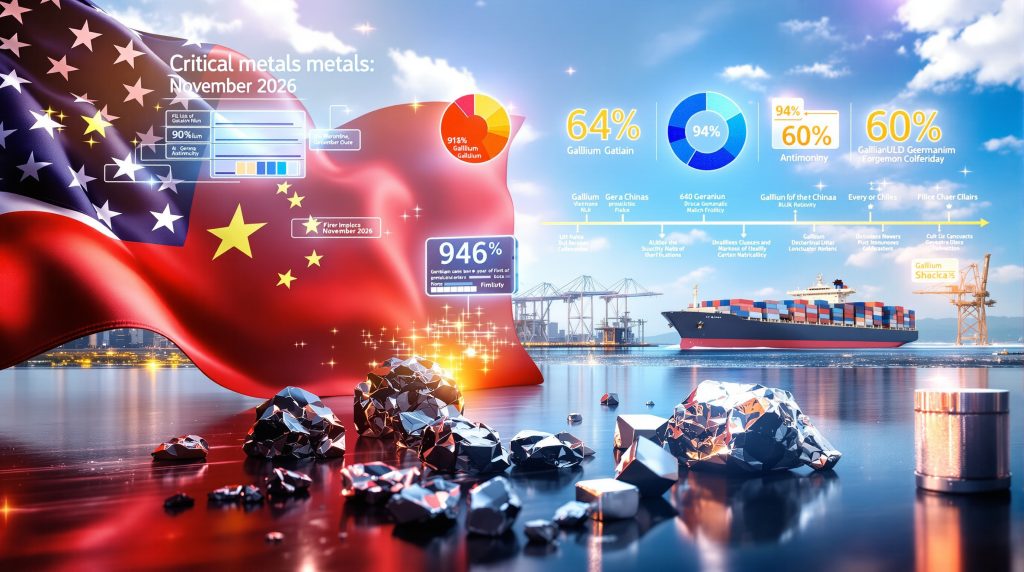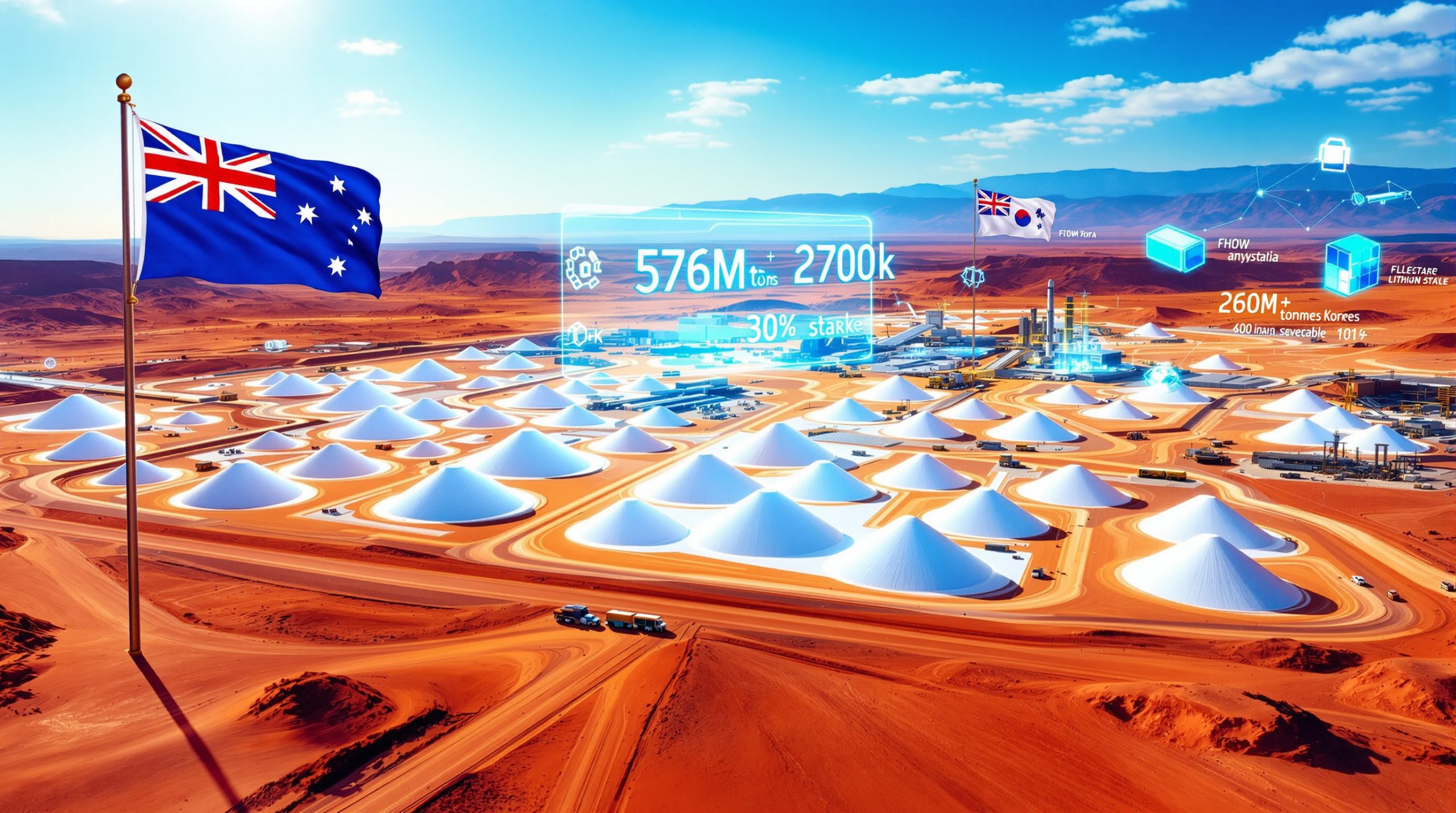What Does China's Temporary Export Ban Suspension Mean for Global Supply Chains?
China's decision to temporarily suspend its critical metal export ban represents a significant shift in global supply chain dynamics that has been nearly two years in the making. On November 9, 2025, China's Ministry of Commerce announced the suspension of restrictions on gallium, germanium, and antimony exports to the United States, marking the latest development in an ongoing trade dispute that has affected industries worldwide. This development comes at a crucial time when strategic antimony financing initiatives are gaining momentum globally.
The suspension, which remains effective until November 27, 2026, provides temporary relief to manufacturers who have faced severe shortages since China temporarily lifts critical metal ban in December 2024. This policy reversal signals a potential de-escalation in trade tensions, though significant regulatory controls remain in place through licensing requirements and military end-user restrictions. Furthermore, this development coincides with broader discussions about critical minerals energy security and supply chain resilience.
Understanding the Strategic Context Behind the Policy Reversal
The temporary lifting of export restrictions follows a complex sequence of diplomatic and economic developments. Recent diplomatic exchanges between US President Donald Trump and Chinese President Xi Jinping in South Korea appear to have influenced China's decision to ease these particular trade restrictions, suggesting that high-level diplomatic engagement continues to play a crucial role in resolving bilateral trade disputes.
This policy adjustment demonstrates China's strategic approach to maintaining economic leverage while responding to diplomatic pressure. By keeping licensing requirements in place, China retains significant control over supply chains while appearing to make meaningful concessions on trade restrictions. Moreover, this development reflects the ongoing US‑China trade impact on global commodity markets.
Timeline of Critical Metal Trade Restrictions Between China and the US
The evolution of China's export controls reveals a calculated escalation strategy:
August 2023 to September 2024: China implemented partial export restrictions on gallium, germanium, and antimony as trade tensions began to intensify.
December 2024: Following Washington's introduction of new semiconductor-sector restrictions, China escalated to a total export ban specifically targeting the United States.
November 2025: After nearly one year of total restrictions, China announced the temporary suspension, creating a 13-month window for normalized trade relations.
This timeline demonstrates how trade policy has become increasingly intertwined with broader geopolitical considerations. Each escalation serves as a response to perceived economic aggression from trading partners, highlighting the interconnected nature of modern trade relationships.
Which Critical Metals Are Affected by China's Temporary Lifting?
Gallium: The Semiconductor Industry's Essential Component
Gallium stands as perhaps the most critical of the three metals affected by China temporarily lifts critical metal ban. China's overwhelming dominance in gallium production, accounting for 94% of global supply according to European Union reports from 2024, creates unprecedented supply chain vulnerabilities for technology-dependent economies.
| Global Gallium Production Share | Percentage |
|---|---|
| China | 94% |
| Rest of World | 6% |
The metal's applications span across multiple high-technology sectors:
• Integrated circuits: Essential for semiconductor manufacturing processes
• LED technology: Critical component in energy-efficient lighting systems
• Photovoltaic solar panels: Enables high-efficiency solar energy conversion
• Radio frequency devices: Powers mobile communication infrastructure
"Gallium arsenide and gallium nitride compounds are irreplaceable in high-frequency and high-power electronic applications, making this metal essential for maintaining technological competitiveness in telecommunications and defense sectors."
Germanium's Role in Advanced Technology Manufacturing
Germanium occupies a crucial position in fiber-optic communications and infrared technology applications. China maintains a major share of global germanium production, though exact figures vary depending on market conditions and production capacity utilisation rates.
Primary applications include:
• Fiber-optic systems: Enables high-speed data transmission infrastructure
• Infrared technology: Critical for thermal imaging and night vision systems
• Solar cells: Specialised applications in space-based photovoltaic systems
• Optoelectronic devices: Powers advanced sensor and detection equipment
The semiconductor industry relies heavily on germanium for specialised applications where silicon cannot provide adequate performance characteristics. During the export ban period, US manufacturers faced significant challenges in securing alternative sources, highlighting the concentrated nature of global germanium production.
Antimony's Military and Industrial Applications
Antimony serves dual-use applications across both civilian and military sectors, making it a particularly sensitive material in trade discussions. China's dominant position in global antimony production creates strategic vulnerabilities for defence-dependent nations.
| Global Antimony Applications | Industry Sector | Critical Use Cases |
|---|---|---|
| Flame Retardants | Consumer Products | Textiles, building materials, electronics |
| Ammunition | Defence | Bullet hardening, explosive applications |
| Battery Technology | Energy Storage | Specialised battery chemistries |
| Electronics | Technology | Semiconductor applications |
The military applications of antimony make it subject to particularly stringent export controls. China maintains absolute restrictions on exports to US military end-users even during the current suspension period. This selective approach demonstrates how critical materials can be used as tools of economic statecraft.
How Long Will China's Export Ban Suspension Last?
The November 2026 Timeline and Its Implications
The November 27, 2026 expiration date for China's temporary suspension creates a 13-month window that appears strategically timed to coincide with broader political and economic cycles. This timeline provides sufficient duration for manufacturers to rebuild inventories and explore alternative supply sources while maintaining Chinese leverage over long-term supply security.
The specific end date suggests several potential considerations:
Political Calendar Alignment: The timeline extends through the 2026 US midterm elections, potentially allowing for policy continuity regardless of electoral outcomes.
Economic Planning Cycles: The 13-month duration aligns with typical annual budgeting and procurement cycles for major manufacturers.
Negotiation Framework: The defined timeline creates urgency for broader trade agreement discussions while providing concrete deadlines for policy makers.
Licensing Requirements That Remain in Effect
Despite the suspension of total export restrictions, China maintains comprehensive regulatory control through its dual-use export licensing system. All exporters must obtain government licences from Beijing for overseas sales, creating administrative barriers and maintaining state oversight of critical material flows.
"Military end-user prohibitions remain fully intact, with absolute restrictions continuing for any exports destined for US defence applications, demonstrating China's selective approach to trade normalisation."
Key regulatory requirements include:
• Government licensing: Required for all export transactions
• End-user verification: Detailed documentation of final applications
• Military restrictions: Absolute prohibitions on defence-related exports
• Dual-use controls: Enhanced scrutiny for technology applications
What Triggered China's Decision to Temporarily Lift Export Restrictions?
Diplomatic Developments Between Washington and Beijing
The timing of China's policy reversal coincides closely with recent diplomatic engagement between senior US and Chinese leadership. The meeting between President Trump and President Xi Jinping in South Korea appears to have created conditions for this temporary de-escalation, suggesting that direct diplomatic communication remains effective in resolving specific trade disputes.
This diplomatic breakthrough demonstrates the continued importance of leader-to-leader engagement in managing complex bilateral relationships. The suspension announcement came within days of these high-level discussions, indicating that critical materials trade was likely a significant agenda item during the diplomatic meetings. Additionally, the US critical minerals order may have influenced these negotiations.
Economic Pressures on Both Supply and Demand Sides
Economic factors have created mounting pressure for policy adjustment from multiple directions. US manufacturers faced severe supply shortages that threatened production capabilities across multiple industries, whilst Chinese producers experienced reduced export revenues and market access limitations.
Supply-side pressures include:
• Revenue losses: Chinese producers lost significant export income during the ban period
• Market share erosion: Alternative suppliers began developing competing production capacity
• Industrial capacity underutilisation: Export restrictions reduced operational efficiency
Demand-side impacts affected:
• Production delays: US manufacturers faced inventory shortages and production bottlenecks
• Cost inflation: Alternative sourcing through third countries increased procurement costs
• Supply chain complexity: Indirect sourcing created operational inefficiencies and compliance risks
Strategic Positioning in Global Technology Competition
China's decision reflects broader strategic calculations about maintaining technological influence whilst avoiding complete economic decoupling. The temporary nature of the suspension preserves China's ability to reimpose restrictions whilst demonstrating responsiveness to diplomatic engagement.
The simultaneous easing of restrictions on dual-use graphite products suggests a coordinated approach to trade policy that addresses multiple material categories simultaneously. This comprehensive strategy indicates that China views critical materials as integrated components of broader technology competition rather than isolated trade issues.
How Significant Is China's Market Dominance in These Critical Metals?
Production Statistics That Reveal Supply Chain Vulnerabilities
China's market dominance in critical metals represents one of the most significant supply chain vulnerabilities in the global economy. The concentration of production creates systemic risks that extend far beyond bilateral trade relationships.
| Critical Metal | China's Market Share | Global Significance |
|---|---|---|
| Gallium | 94% | Semiconductor manufacturing |
| Germanium | Major share* | Fiber-optic infrastructure |
| Antimony | Dominant position* | Defence applications |
*Exact percentages vary by source and market conditions
"China produces 94% of global gallium supply, creating unprecedented dependency for technology-driven economies worldwide and highlighting the strategic importance of supply chain diversification initiatives."
Comparing China's Control to Other Critical Mineral Markets
China's dominance in gallium, germanium, and antimony represents part of a broader pattern of concentrated critical mineral production. This concentration creates multiple points of vulnerability across different technology sectors and defence applications.
Comparative market concentrations:
• Rare earth elements: China controls approximately 85% of processing capacity
• Lithium processing: China dominates battery-grade lithium production
• Graphite: Natural graphite production heavily concentrated in China
• Cobalt processing: Significant Chinese control despite African mining dominance
Alternative Supply Sources and Their Current Limitations
Developing alternative supply sources faces significant challenges including limited geological deposits, processing capacity constraints, and substantial capital investment requirements. Current alternative sources remain insufficient to replace Chinese production in the near term, highlighting the need for initiatives like the European critical minerals facility.
Development challenges include:
- Geological scarcity: Limited high-grade deposits outside China
- Processing expertise: Specialised metallurgical knowledge concentrated in Chinese facilities
- Capital requirements: Substantial investment needed for production facility development
- Timeline constraints: Years required for new production capacity development
- Economic viability: Higher production costs in alternative locations
What Industries Will Benefit Most from This Temporary Relief?
Semiconductor Manufacturing and Technology Sectors
The semiconductor industry represents the primary beneficiary of China temporarily lifts critical metal ban, with gallium playing an irreplaceable role in advanced chip manufacturing processes. US semiconductor companies had faced significant production constraints during the ban period, forcing expensive supply chain adaptations and inventory management challenges.
Specific applications benefiting include:
• Consumer electronics: Smartphone and computer processor manufacturing
• Automotive semiconductors: Electric vehicle and autonomous driving systems
• 5G infrastructure: High-frequency communication equipment
• Data center processors: Advanced server and cloud computing hardware
Case Study Impact: During the export ban, several US chip manufacturers reported supply chain disruptions that forced production schedule adjustments and increased procurement costs through alternative sourcing arrangements. The temporary suspension provides immediate relief for inventory rebuilding and production normalisation.
Defence and Military Technology Applications
Military and defence applications face continued restrictions even during the suspension period, as China maintains absolute prohibitions on exports to US military end-users. However, civilian applications that support dual-use technologies may benefit from improved material availability.
Defence sector impacts:
• Infrared systems: Germanium essential for thermal imaging equipment
• Communication systems: Gallium-based components in military communications
• Ammunition production: Antimony hardening agents in specialised munitions
• Electronic warfare: Advanced semiconductor applications in defence electronics
Clean Energy and Solar Panel Production
The renewable energy sector, particularly solar panel manufacturing, relies heavily on gallium for high-efficiency photovoltaic applications. The temporary suspension provides critical supply relief for US clean energy initiatives and manufacturing capacity expansion.
Solar industry benefits:
• Multi-junction solar cells: Gallium arsenide enables superior efficiency rates
• Concentrated photovoltaics: Advanced solar tracking and concentration systems
• Space applications: Satellite and space-based solar power systems
• Research development: Next-generation photovoltaic technology advancement
How Are US Companies Responding to the Temporary Suspension?
Supply Chain Diversification Strategies Already in Motion
US manufacturers have accelerated supply chain diversification initiatives, recognising that China temporarily lifts critical metal ban creates ongoing vulnerability. Companies are pursuing multiple strategies to reduce dependency on Chinese sources whilst taking advantage of the current supply window.
Diversification approaches include:
- Geographic diversification: Developing supply relationships with alternative countries
- Vertical integration: Investing in domestic processing capabilities
- Strategic partnerships: Forming alliances with non-Chinese producers
- Technology substitution: Research into alternative materials and processes
- Recycling enhancement: Improving recovery rates from existing applications
Stockpiling Behaviours and Strategic Reserve Building
Companies are using the suspension period to rebuild depleted inventories and establish strategic reserves that can buffer against future supply disruptions. This stockpiling behaviour reflects lessons learned from the recent ban period and recognition of ongoing geopolitical risks.
Stockpiling strategies include:
• Emergency reserves: Building inventory buffers for critical applications
• Strategic partnerships: Collaborative inventory management with suppliers
• Forward contracting: Securing long-term supply agreements during available windows
• Quality verification: Ensuring alternative sources meet technical specifications
Investment in Domestic Production Capabilities
The export restrictions have catalysed increased investment in domestic production capabilities, with both private companies and government agencies recognising the strategic importance of reducing foreign dependency for critical materials.
Investment areas include:
• Processing facilities: Developing domestic metallurgical capabilities
• Research development: Advancing extraction and purification technologies
• Workforce training: Building specialised technical expertise
• Infrastructure development: Supporting transportation and logistics capabilities
What Export Controls and Restrictions Still Remain in Place?
Military End-User Prohibitions That Continue
China maintains absolute restrictions on exports to US military end-users, demonstrating the selective nature of the current suspension. These prohibitions ensure that defence applications remain subject to complete export bans regardless of the temporary civilian market relief.
"Dual-use technology restrictions remain unchanged, with enhanced scrutiny applied to any applications that could have military or defence implications, ensuring that China retains significant leverage over strategic technology development."
Prohibited military applications include:
• Defence contractors: Direct military suppliers face continued restrictions
• Weapons systems: Ammunition and weapons manufacturing applications
• Military electronics: Defence-specific semiconductor and electronic applications
• Surveillance systems: Military-grade sensor and detection equipment
Licensing Requirements for All Export Transactions
Despite the suspension, comprehensive licensing requirements remain in effect for all export transactions. This regulatory framework ensures that China maintains oversight and control over critical material flows even during periods of normalised trade relations.
Licensing process requirements:
- Application submission: Detailed documentation of intended use and end-users
- Technical specifications: Precise material requirements and quality standards
- End-user verification: Confirmation of civilian applications and compliance
- Ongoing monitoring: Continued oversight of material usage and distribution
- Renewal procedures: Regular review and reapproval of export authorisations
Third-Country Routing and Compliance Challenges
The licensing system creates complex compliance challenges for companies that had developed third-country sourcing arrangements during the ban period. These indirect supply chains must now navigate dual regulatory frameworks whilst ensuring compliance with both US and Chinese requirements.
Compliance considerations include:
• Documentation requirements: Comprehensive tracking of material origins and processing
• Regulatory coordination: Managing dual jurisdiction compliance obligations
• Cost implications: Administrative overhead for complex supply chain management
• Risk management: Ongoing assessment of regulatory and geopolitical risks
Could This Temporary Suspension Become Permanent?
Factors That Could Influence Long-Term Policy Direction
The permanence of China's export suspension depends on multiple interconnected factors that extend far beyond bilateral trade considerations. The temporary nature of the current arrangement suggests that China views this as a conditional policy experiment rather than a permanent strategic shift.
Key influence factors include:
Diplomatic Relations: Continued progress in US-China diplomatic engagement and broader trade agreement development
Economic Conditions: Global economic stability and the relative importance of export revenues for Chinese producers
Strategic Competition: Technology competition dynamics and national security considerations on both sides
Alternative Sources: Development of non-Chinese production capacity and supply chain diversification success
Trade Relationship Indicators to Monitor
Several key indicators will provide early warning signals about the likelihood of policy continuation or reversal after the November 2026 expiration date. According to China temporarily lifts export controls on rare earths and battery materials, such indicators have proven crucial for market analysis.
Critical monitoring indicators:
• Licensing approval rates: Changes in Chinese approval patterns for export licences
• Diplomatic engagement frequency: Regularity and outcomes of high-level bilateral meetings
• Technology transfer policies: Evolution of restrictions on semiconductor and advanced technology trade
• Military tensions: Escalation or de-escalation in broader strategic competition
Alternative Scenarios for Post-2026 Export Policies
Planning for multiple scenarios remains essential given the uncertain nature of geopolitical developments and trade policy evolution. Furthermore, China lifts export ban on gallium, germanium and antimony to US demonstrates the fluid nature of these policies.
Scenario planning considerations:
- Full normalisation: Permanent lifting of restrictions with standard licensing procedures
- Selective continuation: Maintenance of restrictions on specific applications or end-users
- Policy reversal: Return to total export bans under deteriorated diplomatic conditions
- Expanded restrictions: Extension of controls to additional critical materials or countries
How Should Manufacturers Prepare for Potential Future Restrictions?
Building Resilient Supply Chain Strategies
The temporary nature of China's current suspension requires manufacturers to develop comprehensive resilience strategies that can adapt to changing geopolitical conditions whilst maintaining operational efficiency.
Step-by-step resilience development:
- Risk assessment: Comprehensive analysis of critical material dependencies and vulnerability points
- Alternative sourcing: Development of qualified supplier networks outside China
- Inventory optimisation: Strategic stockpiling balanced with carrying cost considerations
- Process flexibility: Design modifications that enable material substitution when necessary
- Monitoring systems: Real-time tracking of geopolitical developments and supply chain risks
| Risk Assessment Framework | High Risk | Medium Risk | Low Risk |
|---|---|---|---|
| Supply concentration | >80% single country | 50-80% single country | <50% single country |
| Alternative sources | None qualified | Limited options | Multiple qualified |
| Strategic importance | Critical to operations | Important but substitutable | Non-essential |
| Lead time impact | >6 months disruption | 3-6 months disruption | <3 months disruption |
Investment Opportunities in Alternative Sources
The current supply window creates opportunities for strategic investment in alternative production capabilities and supply chain development. These investments require careful evaluation of technical feasibility, economic viability, and long-term strategic value.
Investment priority areas:
• Domestic production: Joint ventures and partnerships with emerging domestic producers
• Allied nations: Supply agreements with production facilities in allied countries
• Recycling technology: Advanced materials recovery and processing capabilities
• Research development: Next-generation materials and substitution technologies
Technology Substitution and Material Innovation Pathways
Long-term supply security requires fundamental research into alternative materials and manufacturing processes that can reduce dependency on geopolitically sensitive supply sources.
Innovation pathways include:
• Material substitution: Development of alternative compounds with similar performance characteristics
• Process optimisation: Manufacturing techniques that require lower volumes of critical materials
• Recycling advancement: Improved recovery rates from end-of-life products and manufacturing waste
• Synthetic alternatives: Laboratory-produced materials that can replace mined resources
What Does This Mean for Global Critical Mineral Security?
Implications for Western Technology Independence
China temporarily lifts critical metal ban highlights fundamental vulnerabilities in Western technology supply chains that extend far beyond the three metals directly affected. The episode demonstrates how quickly access to essential materials can be weaponised in broader geopolitical competition.
The concentration of critical material production in single countries creates systemic risks that threaten technological sovereignty and economic security. Western nations must recognise that temporary suspensions provide relief but do not address underlying structural vulnerabilities that remain subject to political manipulation.
Strategic implications include:
• Supply chain resilience: Urgent need for diversified production capabilities across allied nations
• Strategic reserves: Development of comprehensive stockpiling programmes for critical materials
• Technology sovereignty: Investment in domestic production and processing capabilities
• Alliance coordination: Multilateral approaches to critical mineral security and supply chain development
Strategic Lessons for Other Critical Material Supply Chains
The gallium, germanium, and antimony export restrictions provide important lessons that apply to broader critical material supply chains. Similar vulnerabilities exist across multiple material categories where production remains highly concentrated.
Key lessons learned:
- Early warning systems: Development of monitoring capabilities for geopolitical supply chain risks
- Diversification timing: Proactive supply chain development before crisis periods
- Diplomatic engagement: Importance of maintaining communication channels during trade disputes
- Economic interdependence: Recognition that mutual economic interests can moderate extreme policies
- Strategic patience: Long-term investment in alternative sources requires sustained commitment
Long-Term Geopolitical Considerations in Resource Access
The temporary nature of China's export suspension reflects broader trends in economic statecraft and resource nationalism that are likely to intensify as technology competition continues. Critical materials will increasingly become tools of geopolitical influence and strategic competition.
Future considerations include:
Resource Diplomacy: Critical materials becoming central elements of international negotiation and alliance formation
Technology Competition: Accelerating development of alternative technologies and materials to reduce strategic dependencies
Alliance Building: Coordinated approaches among democratic nations to develop secure supply chains for critical materials
Economic Resilience: Integration of supply chain security considerations into broader economic and security planning
"The temporary suspension of China's critical metal export restrictions represents both immediate relief and a clear warning about the vulnerabilities inherent in concentrated supply chains for essential materials."
The current window provides a crucial opportunity for manufacturers, governments, and allied nations to address structural supply chain vulnerabilities whilst maintaining the diplomatic engagement necessary to prevent future crises. Success in building resilient supply chains will require unprecedented coordination between private industry, government agencies, and international partners committed to maintaining technological sovereignty and economic security in an increasingly complex global environment.
Disclaimer: This analysis is based on publicly available information as of November 2025. Trade policies and diplomatic relationships remain subject to rapid change based on evolving geopolitical conditions. Manufacturers and investors should consult current official sources and professional advisors when making strategic decisions related to critical material supply chains.
Ready to Stay Ahead of Critical Mineral Market Developments?
Discovery Alert's proprietary Discovery IQ model delivers real-time alerts on significant ASX mineral discoveries, instantly empowering subscribers to identify actionable opportunities ahead of the broader market. With geopolitical tensions affecting global supply chains, understanding which companies are advancing critical mineral projects becomes essential for maintaining a competitive edge—begin your 30-day free trial today at Discovery Alert to position yourself ahead of market movements.




